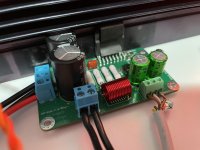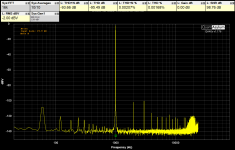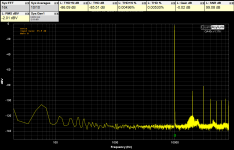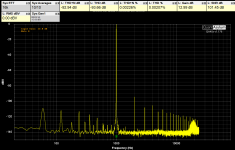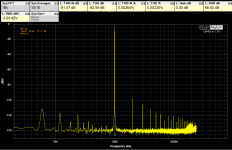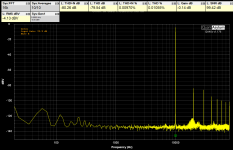Hi all,
I was curious what is this LM1876 dual amp chip is and what kind of performance can I get out of it if I put two built in channels in parallel.
I was surprised to find out that it has way less distortion comparing to the LM1875.
And upon comparing schematics from the datasheet it was clear that both are not the same.
LM1876 is rather similar to the famous LM3886, just lower power version.
Also, 3rd harmonics being predominant over 2nd indicates that there is some level of crossover distortion - although it is below of threshold of hearing.
Overall it is s great affordable chip with very low THD for mid to low power applications.
Results:
Power supply
27.7V at idle
Gain: 25.74dB
SNR: 98.78dB
Sensitivity: 0.660mV
8ohm
PSU: 26.5V under the load
15.7Vrms max output
30W into 8 ohms
THD+N: 0.0021% or -93.66dB at 1kHz
THD+N: 0.0049% or -86.09dB at 10kHz
Heatsink barely got hot.
4ohm
PSU: 25.8V under the load
13 Vrms max output
42W into 4 ohms
THD+N: 0.0026% or -91.7dB at 1kHz
THD+N: 0.0114% or -78.8dB at 10kHz
Heatsink got warm.
4ohm 5W output
THD+N: 0.0023% or -92.94dB at 1kHz
Listening tests:
Wow!!! It sounds so good! Exactly like LM3886.
At lower volumes.
Clear mids. Really pleasant to listen to.
Bass is goooood!!! Although not as powerful.
Once I turned it up - lacks dynamics, just a little.
Maybe because of lower sensitivity ELAC speakers that I used.
It got impressively loud though.
Even with ELACs.
I'm impressed. I would say it performs 75% of LM3886.
Overall great little chip for the money, especially that LM3886 is nowhere to find.
I was curious what is this LM1876 dual amp chip is and what kind of performance can I get out of it if I put two built in channels in parallel.
I was surprised to find out that it has way less distortion comparing to the LM1875.
And upon comparing schematics from the datasheet it was clear that both are not the same.
LM1876 is rather similar to the famous LM3886, just lower power version.
Also, 3rd harmonics being predominant over 2nd indicates that there is some level of crossover distortion - although it is below of threshold of hearing.
Overall it is s great affordable chip with very low THD for mid to low power applications.
Results:
Power supply
27.7V at idle
Gain: 25.74dB
SNR: 98.78dB
Sensitivity: 0.660mV
8ohm
PSU: 26.5V under the load
15.7Vrms max output
30W into 8 ohms
THD+N: 0.0021% or -93.66dB at 1kHz
THD+N: 0.0049% or -86.09dB at 10kHz
Heatsink barely got hot.
4ohm
PSU: 25.8V under the load
13 Vrms max output
42W into 4 ohms
THD+N: 0.0026% or -91.7dB at 1kHz
THD+N: 0.0114% or -78.8dB at 10kHz
Heatsink got warm.
4ohm 5W output
THD+N: 0.0023% or -92.94dB at 1kHz
Listening tests:
Wow!!! It sounds so good! Exactly like LM3886.
At lower volumes.
Clear mids. Really pleasant to listen to.
Bass is goooood!!! Although not as powerful.
Once I turned it up - lacks dynamics, just a little.
Maybe because of lower sensitivity ELAC speakers that I used.
It got impressively loud though.
Even with ELACs.
I'm impressed. I would say it performs 75% of LM3886.
Overall great little chip for the money, especially that LM3886 is nowhere to find.
Attachments
Last edited:
H
HAYK
The crossover occurs 5 times a cycle, thus it generates 5th harmonic and above. Perfect class AB should not generate any even harmonics, this why the outputs are matched.
While I am not sure i can follow here ...The crossover occurs 5 times a cycle
... I do confirm this!it generates 5th harmonic and above
Can you elaborate?The crossover occurs 5 times a cycle, thus it generates 5th harmonic and above. Perfect class AB should not generate any even harmonics, this why the outputs are matched.
What do you mean by matched outputs?
Thanks
Is there a schematic? Can it be turned to basic current drive?
I will probably release sch schematics at some point in the future for everyone.
Current drive - not sure. I don’t know much about it except there is already schematics for LM3886 called myref.
Tom did measurements for that one using Audio Precision analyzer - https://neurochrome.com/pages/myref-fremen-edition
